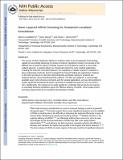Nanolayered siRNA Dressing for Sustained Localized Knockdown
Author(s)
Wang, Mary; Hammond, Paula T; Castleberry, Steven A
DownloadHammond_Nanolayered siRNA.pdf (2.955Mb)
PUBLISHER_POLICY
Publisher Policy
Article is made available in accordance with the publisher's policy and may be subject to US copyright law. Please refer to the publisher's site for terms of use.
Terms of use
Metadata
Show full item recordAbstract
The success of RNA interference (RNAi) in medicine relies on the development of technology capable of successfully delivering it to tissues of interest. Significant research has focused on the difficult task of systemic delivery of RNAi; however its local delivery could be a more easily realized approach. Localized delivery is of particular interest for many medical applications, including the treatment of localized diseases, the modulation of cellular response to implants or tissue engineering constructs, and the management of wound healing and regenerative medicine. In this work we present an ultrathin electrostatically assembled coating for localized and sustained delivery of short interfering RNA (siRNA). This film was applied to a commercially available woven nylon dressing commonly used for surgical applications and was demonstrated to sustain significant knockdown of protein expression in multiple cell types for more than one week in vitro. Significantly, this coating can be easily applied to a medically relevant device and requires no externally delivered transfection agents for effective delivery of siRNA. These results present promising opportunities for the localized administration of RNAi.
Date issued
2013-05Department
Harvard University--MIT Division of Health Sciences and Technology; Massachusetts Institute of Technology. Department of Chemical Engineering; Koch Institute for Integrative Cancer Research at MITJournal
ACS Nano
Publisher
American Chemical Society (ACS)
Citation
Castleberry, Steven, Mary Wang, and Paula T. Hammond. “Nanolayered siRNA Dressing for Sustained Localized Knockdown.” ACS Nano 7, no. 6 (June 25, 2013): 5251–5261.
Version: Author's final manuscript
ISSN
1936-0851
1936-086X